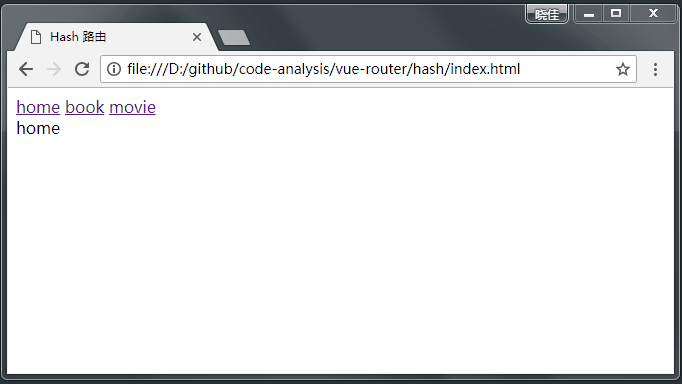这期内容当中小编将会给大家带来有关使用vue-router怎么实现前端路由,文章内容丰富且以专业的角度为大家分析和叙述,阅读完这篇文章希望大家可以有所收获。
前端路由
Hash 路由
url 的 hash 是以 # 开头,原本是用来作为锚点,从而定位到页面的特定区域。当 hash 改变时,页面不会因此刷新,浏览器也不会向服务器发送请求。
http://www.xxx.com/#/home
同时, hash 改变时,并会触发相应的 hashchange 事件。所以,hash 很适合被用来做前端路由。当 hash 路由发生了跳转,便会触发 hashchange 回调,回调里可以实现页面更新的操作,从而达到跳转页面的效果。
window.addEventListener('hashchange', function () { console.log('render'); });History 路由
HTML5 规范中提供了 history.pushState 和 history.replaceState 来进行路由控制。通过这两个方法,可以实现改变 url 且不向服务器发送请求。同时不会像 hash 有一个 # ,更加的美观。但是 History 路由需要服务器的支持,并且需将所有的路由重定向到根页面。
History 路由的改变不会去触发某个事件,所以我们需要去考虑如何触发路由更新后的回调。
有以下两种方式会改变 url:
调用 history.pushState 或 history.replaceState;
点击浏览器的前进与后退。
第一个方式可以封装一个方法,在调用 pushState(replaceState)后再调用回调。
function push (url) { window.history.pushState({}, null, url); handleHref(); } function handleHref () { console.log('render'); }第二个方式,浏览器的前进与后退会触发 popstate 事件。
window.addEventListener('popstate', handleHref);路由实现
我们通过 <a> 标签来进行切换路由,通过一个 <div> 标签来装载各路由对应的页面内容。
参考 vue-router 的调用,我们会这么地调用一个 Router ,将路由与对应组件作为参数传入:
const router = new Router([ { path: '/', component: 'home' }, { path: '/book', component: 'book' }, { path: '/movie', component: 'movie' } ]);数组里是各路由对应的要显示的内容,接下来就来开始实现这个 Router 。
Hash 路由实现
Hash 路由 <a> 标签都需要带上 # :
<div> <a href="#/" rel="external nofollow" >home</a> <a href="#/book" rel="external nofollow" >book</a> <a href="#/movie" rel="external nofollow" >movie</a> <div id="content"></div> </div>
Router 的代码实现如下:
class Router { constructor (options) { this.routes = {}; this.init(); // 遍历,绑定视图更新 options.forEach(item => { this.route(item.path, () => { document.getElementById('content').innerHTML = item.component; }); }); } // 绑定监听事件 init () { window.addEventListener('load', this.updateView.bind(this), false); window.addEventListener('hashchange', this.updateView.bind(this), false); } // 更新试图 updateView () { const currentUrl = window.location.hash.slice(1) || '/'; this.routes[currentUrl] && this.routes[currentUrl](); } // 将路由与回调函数关联 route (path, cb) { this.routes[path] = cb; } }实现效果如下:

History 路由实现
History 路由需要服务器的支持,可以点击这里 的代码参考。
<div> <a href="javascript:void(0);" rel="external nofollow" rel="external nofollow" rel="external nofollow" data-href="/" rel="external nofollow" >home</a> <a href="javascript:void(0);" rel="external nofollow" rel="external nofollow" rel="external nofollow" data-href="/book" rel="external nofollow" >book</a> <a href="javascript:void(0);" rel="external nofollow" rel="external nofollow" rel="external nofollow" data-href="/movie" rel="external nofollow" >movie</a> <div id="content"></div> </div>
Router 的代码实现如下:
class Router { constructor (options) { this.routes = {}; this.init(); this.bindEvent(); // 遍历,绑定视图更新 options.forEach(item => { this.route(item.path, () => { document.getElementById('content').innerHTML = item.component; }); }); } // 绑定点击事件 bindEvent () { const _this = this; const links = document.getElementsByTagName('a'); [].forEach.call(links, link => { link.addEventListener('click', function () { const url = this.getAttribute('data-href'); _this.push(url); }); }); } // 绑定监听事件 init () { window.addEventListener('load', this.updateView.bind(this), false); window.addEventListener('popstate', this.updateView.bind(this), false); } push (url) { window.history.pushState({}, null, url); this.updateView(); } // 更新试图 updateView () { const currentUrl = window.location.pathname || '/'; this.routes[currentUrl] && this.routes[currentUrl](); } // 将路由与回调函数关联 route (path, cb) { this.routes[path] = cb; } }上述就是小编为大家分享的使用vue-router怎么实现前端路由了,如果刚好有类似的疑惑,不妨参照上述分析进行理解。如果想知道更多相关知识,欢迎关注亿速云行业资讯频道。
免责声明:本站发布的内容(图片、视频和文字)以原创、转载和分享为主,文章观点不代表本网站立场,如果涉及侵权请联系站长邮箱:is@yisu.com进行举报,并提供相关证据,一经查实,将立刻删除涉嫌侵权内容。